
Scientists at the Wellcome Sanger Institute, the University of Cambridge, and EMBL’s European Bioinformatics Institute (EMBL-EBI) have unveiled a transformative tool named CellHint. The methodology leverages machine learning to organize and categorize single-cell data, paving the way for the creation of harmonized datasets crucial for advancing the understanding of human health and disease.
Reporting in Cell, the researchers demonstrated the capabilities of CellHint by applying it to investigate connections between healthy and diseased lung cell states across eight different diseases. The study showcased the tool’s potential benefits and its broader applications, including its utilization on 12 tissues from 38 datasets, resulting in a meticulously curated cross-tissue database comprising approximately 3.7 million cells.
Single-cell genomics has revolutionized our ability to comprehend the intricacies of the human body at a cellular level. However, one of the challenges in this field has been the lack of a standardized system for naming and organizing the diverse datasets generated by single-cell research. Addressing this issue head-on, the researchers developed CellHint as part of the Human Cell Atlas initiative, which seeks to map every cell type in the human body to enhance our understanding of health and disease.
According to its developers, CellHint’s uniqueness lies in its capacity to unify cell types from independent laboratories, employing a defined graph to illustrate relationships between cell subtypes. This approach offers a comprehensive view of all identified cells across various datasets, overcoming the hurdle of inconsistent cell annotation information from individual studies.
“CellHint stands out from other tools because it makes full use of the often inconsistent but valuable cell annotation information from individual studies, to achieve biologically-driven data integration,” stated Chuan Xu, researcher at the Wellcome Sanger Institute and first author of the study, emphasizing CellHint’s distinctiveness.
Xu expressed excitement about the tool’s potential to facilitate the reuse of molecular and cellular data across laboratories, potentially leading to groundbreaking discoveries in biology.
Sarah Teichmann, senior author from the Wellcome Sanger Institute and co-founder of the Human Cell Atlas, underscored the significance of global collaboration and open data sharing in advancing research. She highlighted CellHint’s role in enabling the unification and sharing of single-cell data, empowering the global research community to contribute to ongoing studies worldwide and driving advancements in health and healthcare.
CellHint is freely accessible worldwide and represents an important step forward in the quest to decipher the complexities of the human body at a cellular level. Its potential to reveal previously undiscovered connections between healthy and diseased cell states opens new avenues for research and holds the promise of transforming our understanding of human health and disease. As the scientific community embraces this innovative tool, the stage is set for a new era of collaborative exploration and discovery in the realm of single-cell research.












